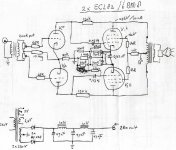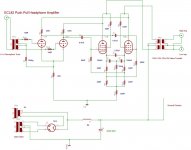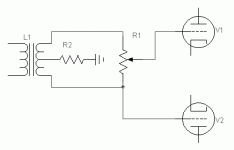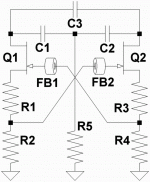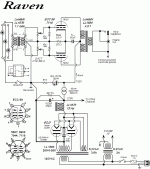Well now I have your attention here is my case.
I took the design of Shoog's headphone amp. A "tabor" inspired design with local feedback, garter bias and grid leak bias. It is an attractive approach because you don't have to balance the tubes (a little goblin inside does the job), I don't see electrolytics in the signal way, it is class A (do not know what it is, but must be o.k.) and the ecl82 has a good reputation in PP.
With the help of Shoog I arrived at the following schematic which I have breadboarded and clip leaded and have listened to since I finished it yesterday.
The question is, can it be bettered/optimized ? It sounds already very good as it is.
Shoog has used a step down input transformer. I use a Cinemag 15/15b that is 1:1.
What I can think of is:
* change the input transformer for a concertina (ecc40/e80cc)
* swap the tubes for ECL86
* I am certainly going to try tube rectification with GZ34 which will give me a B+ of about 250 volt.
* add feedback from plate pentode to grid triode crosswise (from plate V1 to grid V2)
* use inputtransformer followed by FET (a la japanese STC amps)
* use mosfet after triode in "catode-follower" configuration
* use feedback arrangment of baby huey
* use a regulated screensupply
* put a CCS somewhere
* .......
Problem is that I lack tube knowledge, have only my ears and a cheap not very good functioning multimeter for measuremement.
So perhaps there are some experts that can give a helping hand to better this amp.
I think that everybody who still has a room left without a tubeamp should build/own a ECL82/6BM8 PP amp. This should of course be the best possible ECL82 amp, why settle for less. So it is a matter of general interest to optimize this amp (that is already good as it is).
(that is already good as it is).

I took the design of Shoog's headphone amp. A "tabor" inspired design with local feedback, garter bias and grid leak bias. It is an attractive approach because you don't have to balance the tubes (a little goblin inside does the job), I don't see electrolytics in the signal way, it is class A (do not know what it is, but must be o.k.) and the ecl82 has a good reputation in PP.
With the help of Shoog I arrived at the following schematic which I have breadboarded and clip leaded and have listened to since I finished it yesterday.
The question is, can it be bettered/optimized ? It sounds already very good as it is.
Shoog has used a step down input transformer. I use a Cinemag 15/15b that is 1:1.
What I can think of is:
* change the input transformer for a concertina (ecc40/e80cc)
* swap the tubes for ECL86
* I am certainly going to try tube rectification with GZ34 which will give me a B+ of about 250 volt.
* add feedback from plate pentode to grid triode crosswise (from plate V1 to grid V2)
* use inputtransformer followed by FET (a la japanese STC amps)
* use mosfet after triode in "catode-follower" configuration
* use feedback arrangment of baby huey
* use a regulated screensupply
* put a CCS somewhere
* .......
Problem is that I lack tube knowledge, have only my ears and a cheap not very good functioning multimeter for measuremement.
So perhaps there are some experts that can give a helping hand to better this amp.
I think that everybody who still has a room left without a tubeamp should build/own a ECL82/6BM8 PP amp. This should of course be the best possible ECL82 amp, why settle for less. So it is a matter of general interest to optimize this amp

Attachments
This is the original Shoog design
See also this thread: http://www.diyaudio.com/forums/showthread.php?s=&threadid=94977
See also this thread: http://www.diyaudio.com/forums/showthread.php?s=&threadid=94977
Attachments
Always thought R11 in Shoog's design was sorta redundant.
Good to see you have corrected that in your updated version.
Why are we using Blumlein's Garter with a Brute Bridge?
Are we just that scared of Sand?
If you already have cathodes bridged with that much caps,
I don't see why not put matched JFET CCS in both tails? Its
gonna act like one unified tail, except the enforcement of
DC balance is much more absolute.
You could do the same thing for the triode pair up front,
and possibly ditch the transformer. Unless its needed
for some other isolation related purpose.
Good to see you have corrected that in your updated version.
Why are we using Blumlein's Garter with a Brute Bridge?
Are we just that scared of Sand?
If you already have cathodes bridged with that much caps,
I don't see why not put matched JFET CCS in both tails? Its
gonna act like one unified tail, except the enforcement of
DC balance is much more absolute.
You could do the same thing for the triode pair up front,
and possibly ditch the transformer. Unless its needed
for some other isolation related purpose.
kenpeter said:
If you already have cathodes bridged with that much caps,
I don't see why not put matched JFET CCS in both tails? Its
gonna act like one unified tail, except the enforcement of
DC balance is much more absolute.
IIRC, Alan Wright does what you describe in his PP 300B's.
Or use Garter to balance an otherwise unmatched pair of JFETs.
And brute bridge as usual across the high impedance drains to
unify the tail.
Your tail presents only 330 ohms in its current incarnation.
And relies too much on the previous stage to be in balance
for that not to matter.
And as SY pointed out, you got only 22K tail up front, and rely
too much on the input transformer for that not to matter.
Same problem, same fix.
And brute bridge as usual across the high impedance drains to
unify the tail.
Your tail presents only 330 ohms in its current incarnation.
And relies too much on the previous stage to be in balance
for that not to matter.
And as SY pointed out, you got only 22K tail up front, and rely
too much on the input transformer for that not to matter.
Same problem, same fix.
Remember this fact, the original design was always intended as a headphone amp. In this case R11 stiffens the tail a tad, but is mainly there to burn up voltage. In jaap's version I advised him to remove R11 to get his operating point into a better place for his output transformers.
I wanted to try a few ideas on this amp, hence the use of grid leak bias which works exceptionally well and the particular implementation required the input transformers (which I was searc hing for a use for). The Garter bias was also just an experiment and has proved to work very well. Again the proof is the lack of DC in the output toroids. Again for the headphone application the loss of 15V was a bonus. In all my other amps of similar design, I have always used CCS and have found them to work really well.
I am currently listening to this amp through my main system. I would say that it matches my 807 amp of a similar but more sophisticated design. The only thing it lacks is a bit of bass tightness, but the outputs are far from optimal for a 4ohm load !!
My conclusion is that sometimes accepting the compromises is more than enough for excellent listening results.
Shoog
I wanted to try a few ideas on this amp, hence the use of grid leak bias which works exceptionally well and the particular implementation required the input transformers (which I was searc hing for a use for). The Garter bias was also just an experiment and has proved to work very well. Again the proof is the lack of DC in the output toroids. Again for the headphone application the loss of 15V was a bonus. In all my other amps of similar design, I have always used CCS and have found them to work really well.
I am currently listening to this amp through my main system. I would say that it matches my 807 amp of a similar but more sophisticated design. The only thing it lacks is a bit of bass tightness, but the outputs are far from optimal for a 4ohm load !!
My conclusion is that sometimes accepting the compromises is more than enough for excellent listening results.
Shoog
the reason he has done that in the Raven is so that he can keep the input side floating with respect to ground (see the ground lift switch). Since you have grounded yours the situation is not the same. Also when using a single ended input having the transformer floating may introduce hum and so should probably be avoided. There was a recent thread on exactly this topic.
Shoog
Shoog
I have a ECL86 Baby Huey which I enjoy immensely & which Shoog has heard. Unfortunately, I haven't heard his Tabor Clone amp but have heard this headphone amp. It sounded wonderful
I would love to see how to incorporate the baby Huey feedback & ECL86 into this design.
AFAIK the ECL82 sounds a bit harsh at the top end & the ECL86 is a better fluidity here.
The Baby Huey feedback's main advantage is it's ability to the get the most out of a cheap output transformer.
Are you intending to use toroidal trafos?
I would love to see how to incorporate the baby Huey feedback & ECL86 into this design.
AFAIK the ECL82 sounds a bit harsh at the top end & the ECL86 is a better fluidity here.
The Baby Huey feedback's main advantage is it's ability to the get the most out of a cheap output transformer.
Are you intending to use toroidal trafos?
John,
Funfdamentally the Baby Huey and my amp use exactly the same principles and the feedback mechanism is the same. i always thought the best thing you could do with yours was replace the outputs with toroidals.
The Tabor is good and stabler now so we will have to get to9gether again to compare the headphone amp to your Baby Huey and the Tabor.
Shoog
Funfdamentally the Baby Huey and my amp use exactly the same principles and the feedback mechanism is the same. i always thought the best thing you could do with yours was replace the outputs with toroidals.
The Tabor is good and stabler now so we will have to get to9gether again to compare the headphone amp to your Baby Huey and the Tabor.
Shoog
- Status
- This old topic is closed. If you want to reopen this topic, contact a moderator using the "Report Post" button.
- Home
- Amplifiers
- Tubes / Valves
- Could this become a Baby Huey killer ?
